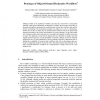Free Online Productivity Tools
i2Speak
i2Symbol
i2OCR
iTex2Img
iWeb2Print
iWeb2Shot
i2Type
iPdf2Split
iPdf2Merge
i2Bopomofo
i2Arabic
i2Style
i2Image
i2PDF
iLatex2Rtf
Sci2ools
100
click to vote
ACIIDS
2011
IEEE
2011
IEEE
Prototype of Object-Oriented Declarative Workflows
While in the traditional workflow processes the control flow is determined statically within process definitions, in declarative workflow processes the control flow is dynamic and implicit, determined by conditions that occur in the workflow data and the service environment. The environment consists of so-called active objects, which play a double role. On the one hand, they are persistent data structures that can be queried and managed according to the syntax and semantics of a query language. On the other hand, active objects possess active parts that are executable and represent workflow processes or tasks. The approach is motivated by features that are desirable in complex and less regular business processes: (1) the possibility of dynamic changes of process instances during their run, (2) mass parallelism of process instances and their components and (3) shifting the availability of resources that workflows deal with on the primary plan as a mean for triggering instances of proces...
| Added | 12 May 2011 |
| Updated | 12 May 2011 |
| Type | Journal |
| Year | 2011 |
| Where | ACIIDS |
| Authors | Marcin Dabrowski, Michal Drabik, Mariusz Trzaska, Kazimierz Subieta |
Comments (0)

